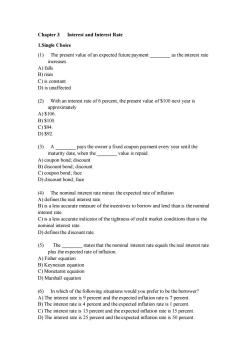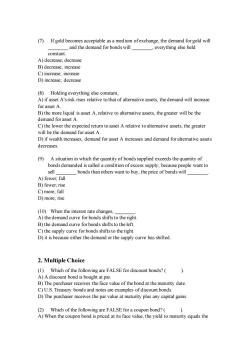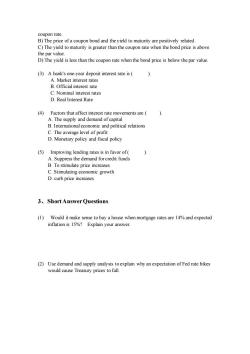同济大学:《货币金融学》课程教学资源(试卷习题)Chapter 3 Interest and Interest Rate

Chapter 3 Interest and Interest Rate 1.Single Choice (1)The present value of an expected future payment as the interest rate increases. A)falls B)rises C)is constant D)is unaffected (2)With an interest rate of 6 percent,the present value of $100 next year is approximately A)$106 B)$100 C)$94 D)$92. (3)A pays the owner a fixed coupon payment every year until the maturity date,when the value is repaid. A)coupon bond;discount B)discount bond;discount C)coupon bond;face D)discount bond;face (4)The nominal interest rate minus the expected rate of inflation A)defines the real interest rate. B)is a less accurate measure of the incentives to borrow and lend than is the nominal interest rate. C)is a less accurate indicator of the tightness of credit market conditions than is the nominal interest rate. D)defines the discount rate. (5)The states that the nominal interest rate equals the real interest rate plus the expected rate of inflation. A)Fisher equation B)Keynesian equation C)Monetarist equation D)Marshall equation (6)In which of the following situations would you prefer to be the borrower? A)The interest rate is 9 percent and the expected inflation rate is 7 percent. B)The interest rate is 4 percent and the expected inflation rate is 1 percent C)The interest rate is 13 percent and the expected inflation rate is 15 percent. D)The interest rate is 25 percent and the expected inflation rate is 50 percent
Chapter 3 Interest and Interest Rate 1.Single Choice (1) The present value of an expected future payment ________ as the interest rate increases. A) falls B) rises C) is constant D) is unaffected (2) With an interest rate of 6 percent, the present value of $100 next year is approximately A) $106. B) $100. C) $94. D) $92. (3) A ________ pays the owner a fixed coupon payment every year until the maturity date, when the ________ value is repaid. A) coupon bond; discount B) discount bond; discount C) coupon bond; face D) discount bond; face (4) The nominal interest rate minus the expected rate of inflation A) defines the real interest rate. B) is a less accurate measure of the incentives to borrow and lend than is the nominal interest rate. C) is a less accurate indicator of the tightness of credit market conditions than is the nominal interest rate. D) defines the discount rate. (5) The ________ states that the nominal interest rate equals the real interest rate plus the expected rate of inflation. A) Fisher equation B) Keynesian equation C) Monetarist equation D) Marshall equation (6) In which of the following situations would you prefer to be the borrower? A) The interest rate is 9 percent and the expected inflation rate is 7 percent. B) The interest rate is 4 percent and the expected inflation rate is 1 percent. C) The interest rate is 13 percent and the expected inflation rate is 15 percent. D) The interest rate is 25 percent and the expected inflation rate is 50 percent

(7)If gold becomes acceptable as a med ium of exchange,the demand for gold will and the demand for bonds will,everything else held constant. A)decrease;decrease B)decrease;increase C)increase;increase D)increase;decrease (8)Holding everything else constant, A)if asset A's risk rises relative to that of alternative assets,the demand will increase for asset A. B)the more liquid is asset A,relative to alternative assets,the greater will be the demand for asset A. C)the lower the expected return to asset A relative to alternative assets,the greater will be the demand for asset A. D)if wealth increases,demand for asset A increases and demand for alternative assets decreases. (9) A situation in which the quantity of bonds supplied exceeds the quantity of bonds demanded is called a condition of excess supply;because people want to sell bonds than others want to buy,the price of bonds will A)fewer;fall B)fewer;rise C)more;fall D)more;rise (10)When the interest rate changes, A)the demand curve for bonds shifts to the right B)the demand curve for bonds shifts to the left. C)the supply curve for bonds shifts to the right. D)it is because either the demand or the supply curve has shifted. 2.Multiple Choice (1)Which of the following are FALSE for discount bonds?(). A)A discount bond is bought at par. B)The purchaser receives the face value of the bond at the maturity date. C)U.S.Treasury bonds and notes are examples of discount bonds D)The purchaser receives the par value at maturity plus any capital gains. (2)Which of the following are FALSE for a coupon bond?(). A)When the coupon bond is priced at its face value,the yield to maturity equals the
(7) If gold becomes acceptable as a medium of exchange, the demand for gold will ________ and the demand for bonds will ________, everything else held constant. A) decrease; decrease B) decrease; increase C) increase; increase D) increase; decrease (8) Holding everything else constant, A) if asset A's risk rises relative to that of alternative assets, the demand will increase for asset A. B) the more liquid is asset A, relative to alternative assets, the greater will be the demand for asset A. C) the lower the expected return to asset A relative to alternative assets, the greater will be the demand for asset A. D) if wealth increases, demand for asset A increases and demand for alternative assets decreases. (9) A situation in which the quantity of bonds supplied exceeds the quantity of bonds demanded is called a condition of excess supply; because people want to sell ________ bonds than others want to buy, the price of bonds will ________. A) fewer; fall B) fewer; rise C) more; fall D) more; rise (10) When the interest rate changes, ________. A) the demand curve for bonds shifts to the right. B) the demand curve for bonds shifts to the left. C) the supply curve for bonds shifts to the right. D) it is because either the demand or the supply curve has shifted. 2. Multiple Choice (1) Which of the following are FALSE for discount bonds? ( ). A) A discount bond is bought at par. B) The purchaser receives the face value of the bond at the maturity date. C) U.S. Treasury bonds and notes are examples of discount bonds. D) The purchaser receives the par value at maturity plus any capital gains. (2) Which of the following are FALSE for a coupon bond? ( ). A) When the coupon bond is priced at its face value, the yield to maturity equals the

coupon rate. B)The price of a coupon bond and the yield to maturity are positively related. C)The yield to maturity is greater than the coupon rate when the bond price is above the par value. D)The yield is less than the coupon rate when the bond price is below the par value. (3)A bank's one-year deposit interest rate is () A.Market interest rates B.Official interest rate C.Nominal interest rates D.Real Interest Rate (4)Factors that affect interest rate movements are () A.The supply and demand of capital B.International economic and political relations C.The average level of profit D.Monetary policy and fiscal policy (5)Improving lending rates is in favor of( A.Suppress the demand for credit funds B.To stimulate price increases C.Stimulating economic growth D.curb price increases 3.ShortAnswer Questions (1)Would it make sense to buy a house when mortgage rates are 14%and expected inflation is 15%?Explain your answer. (2)Use demand and supply analysis to explain why an expectation of Fed rate hikes would cause Treasury prices to fall
coupon rate. B) The price of a coupon bond and the yield to maturity are positively related. C) The yield to maturity is greater than the coupon rate when the bond price is above the par value. D) The yield is less than the coupon rate when the bond price is below the par value. (3) A bank's one-year deposit interest rate is ( ). A. Market interest rates B. Official interest rate C. Nominal interest rates D. Real Interest Rate (4) Factors that affect interest rate movements are ( ). A. The supply and demand of capital B. International economic and political relations C. The average level of profit D. Monetary policy and fiscal policy (5) Improving lending rates is in favor of ( ). A. Suppress the demand for credit funds B. To stimulate price increases C. Stimulating economic growth D. curb price increases 3、Short Answer Questions (1) Would it make sense to buy a house when mortgage rates are 14% and expected inflation is 15%? Explain your answer. (2) Use demand and supply analysis to explain why an expectation of Fed rate hikes would cause Treasury prices to fall
按次数下载不扣除下载券;
注册用户24小时内重复下载只扣除一次;
顺序:VIP每日次数-->可用次数-->下载券;
- 同济大学:《货币金融学》课程教学资源(试卷习题)Chapter 2 Credit and Financial Instruments.docx
- 同济大学:《货币金融学》课程教学资源(试卷习题)Chapter 1 Money and Monetary System.docx
- 同济大学:《货币金融学》课程教学资源(大纲教案)教学大纲 The Economics of Money and Banking.pdf
- 吉林大学:《财政学》课程教学资源(试卷习题)远程教育考试样卷(无答案).doc
- 吉林大学:《经济法》课程电子教案(PPT教学课件,共十三章,授课对象:远程教育,授课教师:孙凤英).ppt
- 《财务管理》课程教学资源(专项报告)南宁市宾阳县生猪现代农业产业园实施方案(简版).pdf
- 《财务管理》课程教学资源(专项报告)存栏1120头商品猪养殖小区可行性研究报告(简版).pdf
- 《财务管理》课程教学资源(专项报告)存栏2000头祖代原种猪场可行性研究报告(简版).pdf
- 《财务管理》课程教学资源(专项报告)存栏3000头曾祖代原种猪场环保生态养殖综合开发项目可研报告(简版).pdf
- 《财务管理》课程教学资源(专项报告)存栏5000头基础母猪现代化生猪养殖场可行性研究报告(简版).pdf
- 《财务管理》课程教学资源(专项报告)山西灵空山国家级自然保护区2016年林业国家级自然保护区补助资金建设项目可行性研究报告(简版).pdf
- 《财务管理》课程教学资源(专项报告)森林康养度假建设项目可行性研究报告(简版).pdf
- 山西农业大学:《财务管理》课程教学资源(试卷习题)财务管理期末考试模拟题三及答案.pdf
- 山西农业大学:《财务管理》课程教学资源(试卷习题)财务管理期末考试模拟题二及答案.pdf
- 山西农业大学:《财务管理》课程教学资源(试卷习题)财务管理期末考试模拟题一及答案.pdf
- 山西农业大学:《财务管理》课程教学资源(试卷习题)第八章 利润分配管理(含答案).pdf
- 山西农业大学:《财务管理》课程教学资源(试卷习题)第七章 营运资金管理(含答案).pdf
- 山西农业大学:《财务管理》课程教学资源(试卷习题)第五章 固定资产投资(含答案).pdf
- 山西农业大学:《财务管理》课程教学资源(试卷习题)第四章 筹资(含答案).pdf
- 山西农业大学:《财务管理》课程教学资源(试卷习题)第九章 财务报表分析(含答案).pdf
- 同济大学:《货币金融学》课程教学资源(试卷习题)Chapter 4 The Economics of Financial Intermediary.docx
- 同济大学:《货币金融学》课程教学资源(试卷习题)Chapter 5 Commercial Banks.docx
- 同济大学:《货币金融学》课程教学资源(试卷习题)Chapter 6 Central Banks.docx
- 同济大学:《货币金融学》课程教学资源(试卷习题)Chapter 7 Financial Markets.docx
- 同济大学:《货币金融学》课程教学资源(试卷习题)Chapter 8 Money Supply and Money Demand.docx
- 同济大学:《货币金融学》课程教学资源(试卷习题)Chapter 9 Money and Inflation.docx
- 同济大学:《货币金融学》课程教学资源(试卷习题)Answers for Test Sample(参考答案)Chapter 1-10.docx
- 同济大学:《货币金融学》课程电子教案(课件讲稿)Chapter 1 Introduction(负责人:郭英).pdf
- 同济大学:《货币金融学》课程电子教案(课件讲稿)Chapter 2 Money and Monetary System.pdf
- 同济大学:《货币金融学》课程电子教案(课件讲稿)Chapter 3 Credit and Financial Instrument.pdf
- 同济大学:《货币金融学》课程电子教案(课件讲稿)Chapter 4 Interest and Interest Rate.pdf
- 同济大学:《货币金融学》课程电子教案(课件讲稿)Chapter 5 Financial Institutions.pdf
- 同济大学:《货币金融学》课程电子教案(课件讲稿)Chapter 6 Commercial Banks.pdf
- 同济大学:《货币金融学》课程电子教案(课件讲稿)Chapter 7 Central Banks.pdf
- 同济大学:《货币金融学》课程电子教案(课件讲稿)Chapter 8 Financial Markets.pdf
- 同济大学:《货币金融学》课程电子教案(课件讲稿)Chapter 10 Monetary Policy.pdf
- 同济大学:《货币金融学》课程电子教案(课件讲稿)Chapter 9 Money Demand and Money Supply.pdf
- 同济大学:《货币金融学》课程电子教案(课件讲稿)Chapter 11 Inflation and Deflation.pdf
- 吉林大学:《会计学》课程电子教案(PPT课件)第一章 绪论(负责人:孙烨).ppt
- 吉林大学:《会计学》课程电子教案(PPT课件)第二章 帐户与复式记帐.ppt
